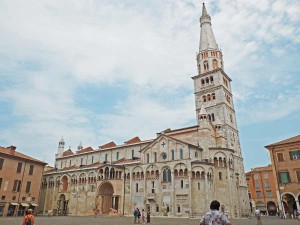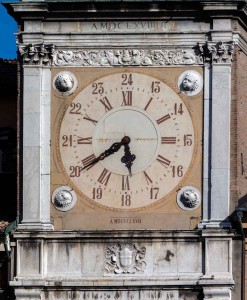
©Bigstock.com/Alvaro German Vilela
A new architectural style made its rounds through Europe in the 11th century. Romanesque architecture with its round arches, thick walls and small windows quickly conquered the entire continent developing many an exciting regional subset. Italy in particularly opened itself up for these new influences that were especially welcomed in Emilia Romagna. Among the most important Romanesque buildings is San Geminiano, the Cathedral of Modena. Together with its 88 m high bell tower (Torre Ghirlandina) and the adjacent Piazza Grande, it is the pride and joy of the Modenese, which is why there was understandable elation when the entire ensemble was declared UNESCO World Heritage Site in 1997. Nowadays, the Piazza with its Romanesque buildings is Modena’s main tourist attraction. We’ll gladly show you why you absolutely must visit this beautiful city in Emilia Romagna soon.
A foray through Modena’s history
The Romanesque extension from the 11th century onward was only one of many highlights in Modena’s highly exciting history. Did you know that the city actually has Etruscan roots? Modena was originally called Mutina before the Boii conquered it before it eventually fell into Roman hands in 222 BC. The now Roman town satisfied important export functions for wine and pottery, but it was left to decay after Attila’s pillages and the Lombard invasion. It took until the late 9th century before reconstruction and fortification commenced.
Modena’s rulers changed several times over the following centuries. It was owned by a margravine when cathedral constructions began, then became a free commune that eventually fell to and was extended by the Este. French occupation and Austrian rule were to follow from the late 18th century onward. Finally and eventually, Modena became part of the centralised state of Italy. The last descendant of the House of Austria-Este died in 1886.
Cathedral of Modena
Naturally, the political unrest left its mark on the cityscape. You probably won’t be too surprised to hear that Duomo San Geminiano isn’t the first church on this lot by a long shot. Actually, there were even two churches here before the city was destroyed after the fall of Rome, both likely built around the 5th century. They were desolated, destroyed and left to decay. Another church was established in mid-11th century, just after the fortification of the city, but it quickly became too small. In addition, the grave of Saint Geminiano, patron saint of the city, was discovered and understandably needed a more prominent place. Plans for a new cathedral were developed quickly, the decision for which was made solely by Modena’s inhabitants in complete imperial and ecclesiastical independence. The Cathedral of Modena became a symbol for freedom and autonomy, the aforementioned free commune was founded only a few decades later.
When construction of today’s cathedral, under the direction of the master builder Lanfranco, eventually began in 1099, Margravine Matilda of Tuscany, one of the most powerful women of her time, supported the city by laying the foundation stone. Pope Lucius III consecrated the Romanesque cathedral on 12 July 1184, but it would take quite a while until all construction were actually completed – 1322, to be precise. What makes the Duomo with its free-standing bell tower, the campanile Torre Ghirlandina, special is the skilful mix of several stylistic periods. While the Romanesque obviously dominates, Gothic elements and Renaissance characteristics create a particularly lively appearance.
You can see the shining white marble of the outer walls from afar. It alternates with grey and reddish stones – likely remains of the former Roman churches. Obviously, you will find characteristic Romanesque elements everywhere, such as the blind arcades and dwarf galleries. The breathtakingly beautiful Gothic oculus attests to the cathedral’s extensive construction history lasting close to 250 years. Numerous reliefs by the sculptor Wiligelmus, a contemporary of Lanfranco, adorn the façade. If you look closely, you discover scenes from the bible as well as depictions of prophets and patriarchs. The King Arthur myth reliefs on the outstanding northern porch of the cathedral, Porta della Pescheria, are just as awe-inspiring.
Rather surprisingly, the interior is lacking the classic cross layout. You won’t find a transept, but a whopping three naves instead. The crypta with a sarcophagus containing the remains of Geminiano can be found on the lower apse level. The central apse was altered decisively in the 18th century and revetted with precious marble. Simultaneously, the altered vaults were given rich stucco embellishments. Anselmo da Campione’s marble parapet with a depiction of the Passion of Christ is just as stunning.
Torre Ghirlandina

©Bigstock.com/v0v
However, the Cathedral of Modena wouldn’t be half as amazing without its campanile. The bell tower Torre Ghirlandina is the symbol of the city, visible from afar and a great point of reference. Originally called Torre di San Geminiano, it rested on a quadrangular base and grew to five floors by 1179. The rivalry with Bologna progressively led to extensions and annexes. An octagonal spire by Arrigo da Campione, who’s also responsible for the cathedral’s pulpit with its terracotta sculptures, followed soon. It was decorated with two festoons (Ital. “ghirlande”) made of marble railing, thus the name Torre Ghirlandina. A look inside the campanile leads you into Sala della Secchia with 15th century frescoes. Don’t miss out on the carved capitals in Sala dei Torresani on the fifth floor either. The five bells in C major date back to the Renaissance.
More attractions on Piazza Grande
The cathedral with its campanile most certainly dominates the stunning Piazza Grande. It is the place where the religious and the secular power of Modena meet. Here are a few more things to discover:
- Palazzo Comunale: Several medieval buildings were linked to form Palazzo Comunale in the 17th Today’s city hall found its home behind the impressive façade with eye-catching arches. In addition, several rooms of historic value are open for visitors. Sala del Fuoco and Sala del Vecchio are lined with glorious paintings and, as such, absolute must-sees.
- Palazzo dell’Arcivescovado: This cute palace with many small details spread across its entire façade is hidden away diagonally opposite the cathedral. Find a small but stunning baroque chapel behind its gates.
- Preda Ringadora: Important personalities, orators and scholars spoke from this massive stone in front of Palazzo Comunale in the Middle Ages. Later, it would serve as a place of rest and peace for the city guards. Eventually, the stone was converted into a pillory for debtors and frauds from the 15th century onward.
- Bonissima: The exact meaning of this mythical medieval statue is unknown. Bonissima has been looking down on the hustle and bustle on the Piazza for centuries. A multi-day culinary festival in her honour has been taken place every October since 2010.
Walk across Piazza Grande with open eyes, the tremendous Torre Ghirlandina always in sight, drawn to the cathedral as if by magic. This particularly magnificent UNESCO World Heritage Site in the heart of Modena continues to amaze. Are you already looking forward to your next city holiday in Emilia Romagna?